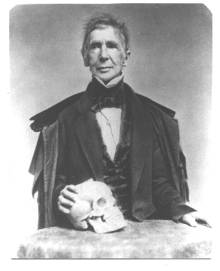John Collins Warren

circa 1850
John Collins Warren (August 1, 1778 – May 4, 1856), of Boston, was one of the most renowned American surgeons of the 19th century. In 1846 he gave permission to William T.G. Morton to provide ether anesthesia while Warren performed a minor surgical procedure. News of this first public demonstration of surgical anesthesia quickly circulated around the world. He was a founder of the New England Journal of Medicine and was the third president of the American Medical Association. He was the first Dean of Harvard Medical School and a founding member of the Massachusetts General Hospital.
Biography

Born in Boston, he was the son of John Warren, well-known doctor, Harvard professor, and a founder of the Harvard Medical School and the nephew of Dr. Joseph Warren. He graduated from Harvard College in 1797, then began the study of medicine with his father. In 1799, he continued his medical studies in London and Paris and Edinburgh, including work with the pioneer anatomist Sir Astley Cooper (1768–1841). He graduated with an M.D. from the University of Edinburgh Medical School in 1801.[1] On his return to America in 1802, Warren entered into partnership with his father and also assisted him with anatomical lectures, dissections, and demonstrations at Harvard Medical School.
He was named Adjunct Professor of Anatomy and Surgery in 1809, then, at his father's death in 1815, assumed the Hersey Professorship of Anatomy and Surgery, which post he held until retirement in 1847. During this time, Warren played a leading role in establishing New England's first medical journal, The New England Journal of Medicine and Surgery (first issue January 1812), which subsequently evolved into today's New England Journal of Medicine. He was also active in the Anthology Club.
Warren was the first dean of Harvard Medical School (1816–1819) and promoted its move from Cambridge to Boston. Harvard presented him with an honorary medical degree in 1819. He was a founding member of Massachusetts General Hospital and served as the facility's first surgeon. He held an appointment on the hospital staff until 1853 and was then on its Board of Consultation until his death. Over the course of his long career, Warren assembled an extraordinary teaching collection of anatomical and pathological specimens, which he presented to Harvard in 1847 along with $5000. This was the beginning of the Warren Anatomical Museum.
Warren and anesthesia
.jpg)
Warren was involved not once but twice in the earliest history of anesthesia. The first incident was a failed demonstration of nitrous oxide by dentist Horace Wells on January 20, 1845. Although Warren did not believe that the anesthesia would work, he arranged for a demonstration at Massachusetts General Hospital. Warren presented Wells to his students but the patient who had been scheduled that morning, for an amputation, refused to be operated. Warren then asked his students if anybody needed a tooth extracted and one student agreed. Unfortunately the gas was not properly administered. The student suffered normal levels of pain, thus discrediting Wells and nitrous oxide as an anesthetic.
Notwithstanding that failure, on October 16, 1846, Warren again agreed to perform a public demonstration of a surgical operation on a patient, this time under ether anesthesia administered by Wells' colleague and competitor, William Thomas Green Morton. Warren was at this time 68 years of age. The operation lasted about ten minutes and the patient was seemingly unconscious for its duration. After Warren had finished, and the patient had regained consciousness, Warren asked the patient how he felt. Reportedly, the patient answered: "Feels as if my neck's been scratched". Warren then stated to his audience "Gentlemen, this is no Humbug". His personal journal for this day records, "Did an interesting operation at the Hospital this morning, while the patient was under the influence of Dr. Morton's preparation to prevent pain. The substance employed was sulphuric ether." Warren was quick to see the remarkable advantages offered by ether in surgical procedures, and he then championed the cause of etherization through his work and publications.
Mindful of the potential importance of the demonstration, Warren had invited noted photographer Josiah Johnson Hawes, of Southworth & Hawes, to document the surgery. However Hawes was squeamish at the sight of blood, and thus he made a daguerrotype of the surgery's re-enactment instead. In subsequent months he was to make a series of daguerrotypes of actual operations. Later Warren presented his Laundy scalpel and probe, the surgical instruments he used in the operation, to Hawes in gratitude for recording some of the earliest anesthesia operations.

Selected works
- Description of an Egyptian mummy, presented to the Massachusetts General Hospital: with an account of the operation of embalming in ancient and modern times. Date uncertain.
- A comparative view of the sensorial and nervous systems in men and animals. Boston, J. W. Ingraham, 1822.
- The preservation of health. With remarks on constipation, old age, use of alcohol in the preparation of medicines. Boston, Ticknor, Reed and Fields, 1854.
- Remarks on some fossil impressions in the sandstone rocks of Connecticut River. Boston, Ticknor and Fields, 1854.
- The Mastodon giganteus of North America. 2d ed., with additions. Boston, Wilson, 1855.
See also
- Boston Medical Library (1805-1826), co-founded by Warren
External links
| Wikimedia Commons has media related to John Collins Warren. |
- ↑ name="White House Physician">"The White House Physician". Retrieved 2013-07-07.
|